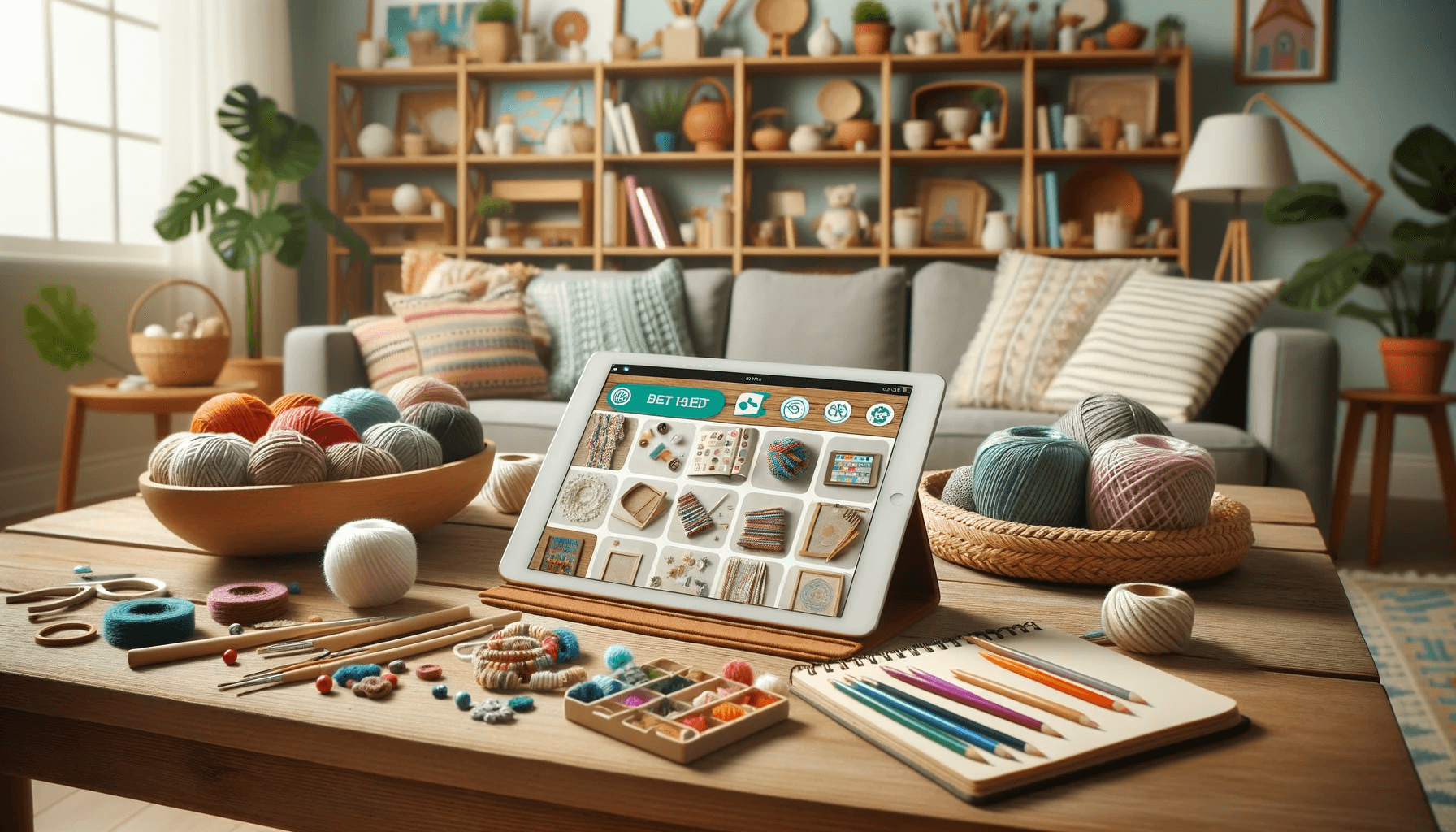Mobile apps have revolutionized various aspects of our lives, including the resurgence of DIY culture. DIY, which stands for Do-It-Yourself, refers to a culture and practice where individuals engage in self-directed projects to create, modify, or repair things without the help of professionals. It promotes creativity, self-sufficiency, and the satisfaction of creating something with one’s own hands.
The history of DIY culture dates back to ancient times when people relied on their skills and knowledge to build and fix things. Over the years, DIY culture has evolved, and with the advent of technology, it has experienced a resurgence in popularity.
One major contributing factor to the resurgence of DIY culture is the proliferation of mobile apps. These apps have provided individuals with easy access to information, tools, and resources needed for various DIY projects. They have transformed the way people engage in DIY activities, making it more accessible and convenient than ever before.
Mobile apps have contributed to the resurgence of DIY culture in multiple ways. They offer a wide range of DIY project ideas and inspiration, allowing individuals to explore different areas of interest. These apps provide step-by-step instructions, tutorials, and video guides that assist users in completing their DIY projects successfully. Mobile apps foster a sense of community and sharing among DIY enthusiasts, enabling them to connect, collaborate, and showcase their creations.
The benefits of mobile apps for DIY enthusiasts are numerous. They offer accessibility and convenience, allowing users to access project ideas and instructions anytime, anywhere. The availability of a wide range of DIY projects caters to various interests and skill levels, ensuring that there is something for everyone. The step-by-step instructions and tutorials provided by these apps make it easier for individuals to learn new skills and techniques. Furthermore, the community aspect of DIY apps fosters interaction, learning, and the exchange of ideas among like-minded individuals.
Mobile apps have also reshaped traditional DIY practices by introducing new techniques and skills. They have facilitated advancements in areas such as woodworking, gardening, home improvement, and crafts, allowing individuals to achieve professional-quality results. The availability of specialized apps for different DIY fields has made it easier for enthusiasts to explore niche areas of interest and master advanced techniques.
Looking ahead, the future of mobile apps in DIY culture is promising. Technological innovations and enhancements will continue to provide users with more immersive and interactive experiences. DIY communities will expand, creating more opportunities for collaboration and knowledge sharing. However, challenges such as privacy and security concerns, reliance on technology, and potential information overload need to be addressed to ensure the sustainable growth of DIY culture in the digital age.
Key takeaways:
- Mobile apps empower DIY culture: Mobile apps have played a significant role in revitalizing DIY culture by providing accessibility, convenience, and a wide range of DIY projects for enthusiasts.
- Advanced tutorials and instructions: Mobile apps offer step-by-step instructions and tutorials, enabling DIY enthusiasts to learn new skills and techniques to further develop their DIY practices.
- Building DIY communities: Mobile apps facilitate the creation of DIY communities, promoting sharing, collaboration, and the expansion of knowledge and skills among DIY enthusiasts worldwide.
What is DIY Culture?
What is DIY Culture?
DIY Culture refers to a movement where individuals engage in activities such as crafting, repairing, and building things on their own rather than relying on professionals or commercial products. It emphasizes self-sufficiency, creativity, and learning new skills. DIY culture has a rich history and has evolved over time, driven by technological advancements. Mobile apps have played a significant role in the resurgence of DIY culture by providing easy access to tutorials, instructions, and a platform for DIY enthusiasts to connect and share their projects. This culture is characterized by accessibility, a wide range of projects, step-by-step guidance, and a vibrant community. Its future is expected to be shaped by technological innovations and an expanding community of DIY enthusiasts.
The History and Evolution of DIY Culture
The history and evolution of DIY culture, also known as “do-it-yourself culture,” can be traced back to ancient times when individuals had to rely on their own skills and resources to create and fix things. Throughout the centuries, this DIY culture has undergone changes and adaptations in response to new technologies and societal shifts.
In recent years, the emergence of mobile apps has revolutionized the DIY movement, providing greater accessibility and interactivity than ever before. These innovative apps offer a diverse range of projects, along with detailed step-by-step instructions, serving as a virtual platform for DIY enthusiasts to connect with one another and share their creations.
As technology continues to advance, the future of mobile apps and the DIY culture appears promising, with new innovations and an expanding community on the horizon.
The Role of Mobile Apps in DIY Culture
The Role of Mobile Apps in DIY Culture
Mobile apps play a crucial role in the resurgence of DIY culture by providing easy access to information, tools, and resources. Here are some ways mobile apps contribute to DIY culture:
- Tutorials and Guides: Mobile apps like YouTube and Pinterest offer step-by-step tutorials and guides for various DIY projects.
- Community Building: Mobile apps like DIY Network and Houzz connect DIY enthusiasts, allowing them to share ideas, tips, and inspiration.
- Tool and Supply Shopping: Mobile apps like Etsy and Amazon make it convenient to browse and purchase DIY supplies and tools.
- Project Management: Mobile apps like Trello and Asana help DIYers stay organized and track their projects’ progress.
- Skill Development: Mobile apps like Skillshare and Udemy offer online courses to develop new DIY skills and techniques.
How Have Mobile Apps Contributed to the Resurgence of DIY Culture?
Mobile apps have played a significant role in the resurgence of DIY culture. They have contributed immensely to the revival of DIY culture by providing a wide range of resources and tools. These apps have made it much easier for individuals to engage in DIY projects, regardless of their skill level or prior experience. Along with step-by-step instructions and tutorials, these mobile apps offer a platform for DIY enthusiasts to connect and share their projects with a vibrant community of like-minded individuals. By doing so, these apps have truly democratized the DIY culture, making it more inclusive and convenient for everyone to participate. These apps have empowered individuals to embrace their creativity and explore their interests in DIY projects. With the continuous advancements in technology, the future of mobile apps and the DIY culture appears to be extremely promising.
To further immerse yourself in the DIY culture, here are a few suggestions:
| 1. Explore various DIY apps available to find the one that aligns with your interests and specific needs. |
| 2. Engage actively with the DIY community by sharing your own projects and seeking inspiration from fellow enthusiasts. |
| 3. Push your boundaries by attempting new and diverse DIY projects, which will effectively broaden your skill set. |
| 4. Make the most of the comprehensive step-by-step instructions and useful tutorials provided by mobile apps to enhance your knowledge and expertise. |
| 5. Embrace the unmatched convenience and accessibility offered by mobile apps, allowing you to engage in DIY projects at your own pace and according to your own schedule. |
Popular DIY Apps and their Features
There are several popular DIY apps available that offer various features to assist users in their DIY projects. These apps provide step-by-step instructions, tutorials, and a platform to share ideas and projects with others in the DIY community.
- Popular DIY Apps and their Features –This app offers a wide range of DIY projects, from home improvement to crafts, with detailed instructions and materials lists.
- Popular DIY Apps and their Features -This app provides useful calculators and converters for DIY projects, such as calculating paint quantities or converting measurements.
- Popular DIY Apps and their Features –Instructables is a popular DIY app that offers how-to guides, videos, and user-generated content for a wide variety of projects.
- Popular DIY Apps and their Features -While not exclusively a DIY app, Pinterest is a great platform to discover DIY project ideas, save them for later, and find inspiration from other users.
- Popular DIY Apps and their Features –TaskRabbit connects users with skilled individuals who can help with various DIY tasks, such as furniture assembly or home repairs.
Benefits of Mobile Apps for DIY Enthusiasts
Digging into the world of mobile apps for DIY enthusiasts opens up a world of possibilities. From accessibility and convenience to a wide range of projects, step-by-step instructions, and a supportive community for sharing, these apps have revolutionized the DIY culture. Get ready to dive into the power of mobile apps in empowering and fueling your DIY passions like never before.
Accessibility and Convenience
In the world of DIY culture, mobile apps have revolutionized accessibility and convenience for enthusiasts. Here are some ways in which these apps have made DIY projects more accessible:
- Step-by-step instructions: Mobile apps provide detailed instructions, making it easier for beginners to follow along.
- Personalized recommendations: These apps suggest projects based on user interests and skill levels, saving time and effort in searching for ideas.
- Material and tool lists: Apps often include lists of required materials and tools for each project, making it convenient to gather everything before starting.
- Video tutorials: Many DIY apps offer video tutorials, allowing users to visually understand each step.
Pro-tip: Before starting a DIY project, make sure to read user reviews and ratings of the app to ensure its reliability and usefulness.
Wide Range of DIY Projects
Mobile apps have revolutionized the world of do-it-yourself enthusiasts by offering a wide range of DIY projects. From home improvement and interior design to crafting and gardening, these apps provide endless possibilities for creativity and self-expression. Whether you’re interested in building furniture, creating artwork, or tackling a small renovation, there is a DIY project available for everyone. Thanks to step-by-step instructions, tutorials, and a community of like-minded individuals, mobile apps have made it easier than ever to explore new hobbies and challenge yourself with a wide variety of DIY projects.
The concept of DIY culture can be traced back to ancient times when individuals had to take on various tasks themselves due to necessity or lack of specialized labor. As society evolved, the popularity of DIY culture grew, especially with the advent of craftsmanship and the rise of the maker movement. Mobile apps have amplified this culture even further by providing access to a vast range of projects and connecting individuals globally.
Step-by-Step Instructions and Tutorials
When it comes to step-by-step instructions and tutorials in the DIY culture, they are invaluable resources for beginners and experienced enthusiasts alike. Here are some key benefits:
- Guidance: Detailed instructions help you understand each stage of the project, ensuring you don’t miss any crucial steps.
- Clarity: Tutorials break down complex tasks into manageable steps, making them easier to follow and achieve success.
- Learning: By following step-by-step instructions and tutorials, you can learn new techniques and skills, expanding your DIY repertoire.
- Empowerment: Step-by-step tutorials give you the confidence to tackle projects you might have otherwise deemed too difficult.
- Personalization: You can adapt and customize projects to suit your preferences and style.
Jane, a DIY enthusiast, used step-by-step instructions and tutorials to transform an old wooden table into a beautiful rustic farmhouse-style piece. The step-by-step instructions and tutorials helped her navigate each stage of the process, and she was delighted with the end result that showcased her newfound woodworking skills.
Community and Sharing
Community and sharing play a vital role in the DIY culture, fostering collaboration, inspiration, and growth among enthusiasts. Mobile apps have revolutionized this aspect by providing platforms for individuals to connect, collaborate, and share their projects with like-minded people.
| Connecting with others: | Mobile apps allow DIYers to connect with a diverse community of like-minded individuals who share similar interests, fostering a sense of belonging and encouragement. |
| Collaborative projects: | Through these apps, DIYers can find opportunities to collaborate on projects, combining their skills and knowledge to create something unique and innovative. |
| Inspiration and ideas: | People can share their DIY projects on these platforms, promoting the community spirit of sharing and providing inspiration and ideas for others to try, furthering their exploration and innovation. |
True story: Emma, an avid DIYer, used a mobile app to share her unique knitting project. Through the app, she connected with other knitters who shared her passion. Together, they organized a knitting workshop where they shared techniques and tips, building a strong community of knitters who continue to support and inspire each other.
Reshaping Traditional DIY Practices
The DIY culture is experiencing a transformative shift thanks to the rise of mobile apps. In this section, we’ll witness how these apps have not only impacted traditional DIY fields but also propelled advancements in techniques and skills. Get ready to discover the exciting ways mobile apps have reshaped the DIY landscape, bringing a fresh wave of creativity and innovation to this hands-on realm.
The Impact of Mobile Apps on Traditional DIY Fields
The impact of mobile apps on traditional DIY fields has been transformative. These innovative apps have completely changed the way individuals participate in DIY projects, offering convenient access to information, step-by-step instructions, and tutorials. Moreover, they have revolutionized traditional DIY practices by introducing novel techniques and fostering the development of new skills. By connecting enthusiasts from all corners of the globe, mobile apps have expanded the DIY community and promoted a culture of sharing and collaboration. However, it is important to acknowledge the challenges and considerations that come with this technological revolution, such as the need for ongoing innovations and the potential risk of becoming too reliant on these apps. Nonetheless, mobile apps are continuing to shape the future of DIY culture, making it more accessible and thrilling for everyone involved.
Advancements in DIY Techniques and Skills
- Advancements in DIY Techniques and Skills have greatly transformed the approach people take towards do-it-yourself projects. Here are several pivotal developments in this realm:
- Online tutorials: DIY enthusiasts now have the ability to access an extensive library of tutorials and guides online, enabling them to acquire new techniques and enhance their skills.
- Technological tools: From state-of-the-art power tools to innovative 3D printers, new technologies have significantly enhanced the efficiency and precision of DIY projects.
- Social media platforms: DIY communities on popular platforms like Instagram and Pinterest have created a space where individuals can share their projects, inspire others, and collaborate effectively.
- Virtual reality: Applications of virtual reality are being utilized to simulate DIY projects, providing invaluable training and practice opportunities without the need for physical materials.
- Crafting apps: Mobile applications entirely dedicated to crafting and DIY projects offer step-by-step instructions, project inspiration, and useful tools for planning and organizing projects.
The Future of Mobile Apps and DIY Culture
As the world becomes increasingly interconnected, mobile apps are paving the way for a resurgence of DIY culture. In this exciting exploration of the future, we’ll uncover the potential that lies within technological innovations and enhancements. We’ll also dive into the expanding DIY communities that are embracing these mobile apps as platforms for creativity and collaboration. And of course, we’ll address the potential challenges and considerations that may arise as this DIY revolution continues to gain momentum. Get ready to witness the merging of technology and creativity like never before!
Technological Innovations and Enhancements
Technological innovations and enhancements have played a significant role in reshaping the DIY culture. Mobile apps have revolutionized the way people engage in DIY projects by introducing new tools and features.
- Virtual Reality (VR) and Augmented Reality (AR): These technologies provide immersive experiences, allowing users to visualize their DIY projects before starting them.
- Smart Home Integration: DIY apps now integrate with smart home devices, enabling users to control and automate various aspects of their projects.
- Artificial Intelligence (AI): AI-powered DIY apps can provide personalized recommendations, suggest creative ideas, and even assist in troubleshooting common challenges.
Fact: Technological advancements, such as technological innovations and enhancements, have not only made DIY projects easier and more accessible, but they have also fostered a sense of creativity and innovation within the DIY community.
Expanding DIY Communities
Connecting DIY enthusiasts: Mobile apps play a crucial role in bringing together like-minded individuals from around the world. They foster a strong sense of community, enabling collaboration and knowledge sharing. Inspiration and motivation: DIY apps provide a unique platform for users to showcase their projects, inspiring others and motivating them to embark on their own DIY journeys. Support and guidance: Mobile app-based DIY communities offer a valuable space for users to seek advice, ask questions, and receive guidance from experienced DIYers. This creates a supportive environment that is particularly beneficial for beginners. Diverse perspectives: The expansion of DIY communities through mobile apps allows individuals with diverse backgrounds and areas of expertise to come together. This contributes to a more inclusive DIY culture that embraces a wide range of perspectives. Networking opportunities: By connecting DIY enthusiasts with professionals and experts in specific DIY fields, mobile apps create valuable opportunities for mentorship, workshops, and collaborations.
Potential Challenges and Considerations
When it comes to the resurgence of DIY culture facilitated by mobile apps, there are several potential challenges and considerations that need to be kept in mind. These potential challenges and considerations include the reliability and accuracy of the DIY instructions provided by mobile apps. It is possible that these instructions may contain incorrect or incomplete information, which can result in unsuccessful projects. Another important consideration is the safety concerns associated with engaging in DIY projects without proper knowledge and experience. Mobile apps should prioritize promoting safety guidelines and precautions to ensure a safe user experience. Additionally, one potential challenge of relying solely on mobile apps for DIY projects is the lack of personal interaction. Traditionally, DIY culture involved collaboration and learning from others, and mobile apps may limit the opportunities for hands-on guidance and the shared experience of working with others. Despite these challenges, mobile apps have played a significant role in the resurgence of DIY culture. However, it is essential to address these potential challenges and considerations to guarantee a positive and safe user experience. On a different note, a study has revealed that DIY enthusiasts are more likely to attempt complex projects after utilizing mobile apps for guidance.
Frequently Asked Questions
1. What is the trend of DIY culture in relation to mobile apps?
The trend of DIY culture in relation to mobile apps refers to the rise of individuals, particularly younger generations, who are creating their own DIY apps without extensive programming skills. They are driven by the desire to be more productive and not have to rely on the IT department to provide them with customized solutions.
2. Why are citizen developers on the rise?
Citizen developers are on the rise due to the availability of user-friendly cloud-based application development platforms, such as Salesforce.com, TrackVia, and Mendix. These platforms have made it easier for individuals without extensive programming knowledge to create customized apps that meet niche needs and increase productivity.
3. How do DIY apps benefit businesses?
DIY apps benefit businesses by allowing them to meet niche needs that many IT departments may be unaware of. These apps are typically used by small teams and are cost-efficient as they eliminate the need to wait for the IT department to develop a solution in-house. DIY apps also empower employees to be more productive and resourceful.
4. How does social media contribute to the DIY trend?
Social media plays a significant role in the DIY trend by providing individuals with access to resources, advice, and inspiration for their projects. For DIY businesses, integrating social media into their marketing strategy is essential as it helps build awareness, respond to customer questions, and network with potential customers. Platforms like Pinterest and YouTube are particularly valuable for DIY companies.
5. What role does Pinterest play in the DIY culture?
Pinterest is an important social media platform for DIY companies as it has high conversion rates and allows for interactivity among customers. It helps DIY businesses become more visible and can contribute to virality. By showcasing products, providing inspiration, and allowing users to save and share ideas, Pinterest plays a crucial role in the DIY culture.
6. How can DIY companies leverage audio and visual coaching in their marketing?
DIY companies can leverage audio and visual coaching through platforms like YouTube. By creating a branded YouTube channel, DIY companies can provide guidance, tutorials, and demonstrate how their products can be used. This form of content marketing is valuable in attracting and engaging customers, as well as showcasing the company’s expertise.






